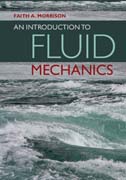
This is a modern and elegant introduction to engineering fluid mechanics enriched with numerous examples, exercises and applications. A swollen creek tumbles over rocks and through crevasses, swirling and foaming. Taffy can be stretched, reshaped and twisted in various ways. Both the water and the taffy are fluids and their motions are governed by the laws of nature. The aim of this textbook is to introduce the reader to the analysis of flows using the laws of physics and the language of mathematics. We delve deeply into the mathematical analysis of flows; knowledge of the patterns fluids form and why they are formed and also the stresses fluids generate and why they are generated is essential to designing and optimising modern systems and devices. Inventions such as helicopters and lab-on-a-chip reactors would never have been designed without the insight provided by mathematical models. INDICE: Part I. Preparing to Study Flow: 1. Why study fluid mechanics?; 2. How fluids behave; Part II. The Physics of Flow: 3. Modeling fluids; 4. Molecular fluid stresses; 5. Stress-velocity relationships; Part III. Flow Field Calculations: 6. Microscopic balance equations; 7. Internal flows; 8. External flows; Part IV. Advanced Flow Calculations: 9. Macroscopic balance equations; 10. How fluids behave (redux); V. Appendices: A. Glossary; B. Mathematics appendix; C. Supplemental mathematics appendix; D. Special topics.
- ISBN: 978-1-107-00353-8
- Editorial: Cambridge University Press
- Encuadernacion: Cartoné
- Páginas: 940
- Fecha Publicación: 15/04/2013
- Nº Volúmenes: 1
- Idioma: Inglés
